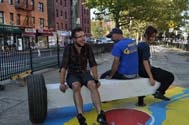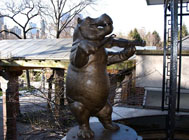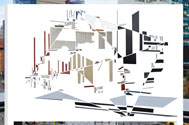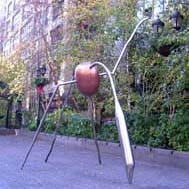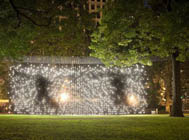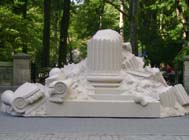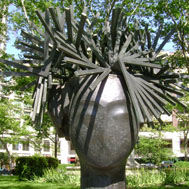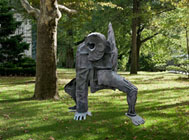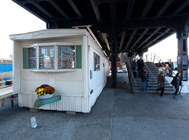Art in the Parks
Through collaborations with a diverse group of arts organizations and artists, Parks brings to the public both experimental and traditional art in many park locations. Please browse our list of current exhibits and our archives of past exhibits below. You can also see past grant opportunities or read more about the Art in the Parks Program.
Public Art Map and Guide
Find out which current exhibits are on display near you, and browse our permanent monument collection.
Search Current and Past Exhibits
2010
Manhattan
Hester Street Collaborative, Mall-terations
October 1, 2010 to Summer 2011
Allen Street Malls, Manhattan, Manhattan
Please note: This is a past exhibit that is no longer installed in the park.
![]()
Stephen Vitiello, A Bell for Every Minute
June 23, 2010 to June 23, 2011
14th Street Passage between West 13th and West 14th streets
The High Line, Manhattan
Please note: This is a past exhibit that is no longer installed in the park.
Artist Stephen Vitiello presents a multi-channel sound installation for which he has recorded bells all over New York City and beyond. Sounds range from the iconic rings of the New York Stock Exchange bell, the historic Dreamland bell (recorded days after it was discovered in the water off Coney Island), the United Nation’s Peace Bell, and more everyday and personal sounds of bike bells, diner bells, and neighborhood church bells. During park hours an individual bell will ring each minute from speakers placed throughout the tunnel space where it will be installed, the overtones fading out as the next bell begins. A chorus of the selected bells will play at the top of each hour, filling the space. The sounds will be represented on physical sound map that identifies the location of each bell, allowing the listener to follow the geographic journey of the recordings. Collectively, the bells are a microcosm of the urban landscape as they relate to the sounds captured throughout the daily life in New York City. The site becomes activated by the composition, inviting the passerby to engage with the High Line and its connection to the city around it.
This is a project by Creative Time and the Friends of the High Line.
![]()
Richard Galpin, Viewing Station
May 7, 2010 to May 1, 2011
High Line, between 17th and 18th streets
The High Line, Manhattan
Please note: This is a past exhibit that is no longer installed in the park.
Richard Galpin alters photographs of cityscapes. His chosen method of manipulation is to cut and remove the top layer of the colored emulsion from his photographic prints, exposing the paper substrate. By eradicating part of the photograph, its imagery becomes transformed to the point of total abstraction. Using clean lines and sharp angles, Galpin’s technique emphasizes geometric forms, recalling early 20th century art movements such as Constructivism, Cubism, and Futurism.
For the High Line, Galpin has created a viewing station that functions similarly to his cut photographs. Park visitors are invited to look through the opening on top of the viewing post, which is lined up with a metal screen from which geometric shapes have been cut. The combination of these two devices abstracts the view of nearby buildings.
Through relatively simple means, the viewing station distorts optical perspective, making it difficult to judge spatial distance. Its isolation of fragmented areas encourages more acute observation of surface details, and subtleties of color and texture. The view looks more like a two-dimensional image – such as a photograph or painting – than three-dimensional space.
This project is presented by Friends of the High Line. For more information, visit Friends of the High Line's public art page.
![]()
Gloria Kisch, Copper Fusion
November 24, 2010 to March 12, 2011
Dag Hammarskjold Plaza, Manhattan
Please note: This is a past exhibit that is no longer installed in the park.
Parks is happy to welcome back Gloria Kisch to the Dag Hammarskjold sculpture plaza. In 2002 Gloria exhibited Octopus II, a monumental stainless steel sculpture from a series called Octopi. Her new work Copper Fusion is made of stainless steel and reaches 14 feet in height.
![]()
Jim Campbell, Scattered Light
October 21, 2010 to February 28, 2011
Madison Square Park, Manhattan
Please note: This is a past exhibit that is no longer installed in the park.
Scattered Light is the New York public art debut of pioneering new media artist Jim Campbell. Campbell’s exhibition features three new major public art commissions, including his largest and most ambitious work to date.
With Scattered Light, Campbell has hung nearly 2,000 LED lights, encased in standard light-bulb casings, from a massive suspension truss standing 20 feet high and stretching 80 feet down the center of the Oval Lawn. These LEDs have been programmed and sequenced by Campbell to turn and off in such a way that from the pathways of Madison Square Park—and from the major avenues beyond the park’s boundaries—it will appear as though the shadows of people and animals are passing across a massive, gently-undulating amorphous field of light.
Broken Window will be an additional work, situated near the main entrance to Madison Square Park at 23rd Street and Fifth Avenue, in which an array of LEDs encased in a glass-brick wall create illuminated moving images that gently pass across the glass plane. Voices in the Subway Station Eighteen features eighteen glass tablets embedded in the grass that emit gentle pulses of light—communicating like passengers on the subway.
This is a project of the Madison Square Park Conservancy.
![]()
Ryan Gander, The Happy Prince
September 15, 2010 to February 13, 2011
Doris C. Freedman Plaza, 60th St. and 5th Ave.
Central Park, Manhattan
Please note: This is a past exhibit that is no longer installed in the park.
“High above the city, on a tall column, stood the statue of the Happy Prince. He was gilded all over with thin leaves of fine gold, for eyes he had two bright sapphires, and a large red ruby glowed on his sword-hilt.” So begins the best-known children’s story by the renowned literary figure, Oscar Wilde (1854–1900). It seems fitting that British artist Ryan Gander (b. 1976) has taken inspiration for his first public commission from the tale of an enchanted monument.
Here Gander has re-imagined the final, climactic moments of Wilde’s story where the statue is destroyed. Aided by a friendly swallow, the prince has given away all of his jewels and gilding to alleviate the suffering of the city’s poor. No longer impressive to city officials, Wilde’s denuded metal statue is melted down.
In Gander’s version, the statue appears to be stone; the fallen swallow and the prince’s indestructible heart lie amidst the rubble. On closer inspection we see that the “ruin” is a single massive object: a sculpture of a ruin. In this way, it functions like a plastic toy ruin, at once descriptive and frankly artificial. Gander’s wry evocation of Wilde’s tale still resonates in our own period of economic inequality. At the same time, it presents a contemporary approach to sculpture, where the role of the public monument remains an open question.
This is a project by the Public Art Fund.
![]()
Manolo Valdes, Manolo Valdes on Broadway
May 20, 2010 to January 23, 2011
Broadway, Various locations, Manhattan
Please note: This is a past exhibit that is no longer installed in the park.
Manolo Valdes on Broadway includes sixteen bronze sculptures along Broadway from Columbus Circle to 166th Street. Each sculpture will include signage that displays mobile phone access numbers for an English and Spanish language audio tour with informative descriptions of the works.
Manolo Valdes is one of the most important and respected Spanish artists working today. Best known for his passion for past masters from Zurbaran to Velazquez, Matisse to Lichtenstein, Valdes uses their work "as a pretext" ("como pretexto") to create an entirely new aesthetic object. For example, six massive sculptures entitled Reina Mariana, each over eight feet in height and weighing over two thousand pounds, depict Queen Mariana as immortalized by Velazquez. Four of these sculptures with their abstract and simplified forms will grace the famous city landmark, Columbus Circle, as well as two at the south entrance to the 72nd Street subway station. Also sited at the subway station is Odalisca, 2006, a sculpture whose subtle forms refer to works of Henri Matisse and Pablo Picasso. Another highlight of the exhibition is the series of six monumental bronzes – all over 12 feet in height – depicting female heads, their calm facial composure and structured equilibrium offset rhythmically by dynamic ornamental head-pieces. The exhibition will also include the New York debut of Valdes' two equestrian sculptures Dama a caballo V, 2008 and Caballero V, 2008, which were inspired by Velazquez's seventeenth-century portraits.
![]()
Various Artists, Statuesque
June 2, 2010 to December 3, 2010
City Hall Park, Manhattan
Please note: This is a past exhibit that is no longer installed in the park.
Public Art Fund brings together a dynamic group of six international artists as they reinvent figurative sculpture for a new era. Statuesque features 10 major works of art by Pawel Althamer, Huma Bhabha, Aaron Curry, Thomas Houseago, Matthew Monahan, and Rebecca Warren. The exhibition is the first time these artists have been shown together, revealing a striking interest in the figure that transcends national boundaries. As the first project curated by Public Art Fund's new Director and Chief Curator Nicholas Baume, Statuesque also marks the New York debut of each work included. In conceiving Statuesque, Baume makes a persuasive argument for the renewed significance of the figure in international contemporary sculpture.
Statuesque celebrates the return of figurative sculpture, but not in the classical sense. Neither literal portraits nor traditional monuments, these works push the expressive potential of sculptural forms and materials. While the approaches and backgrounds of the artists are very different, their work shares a number of key characteristics. They tend towards abstraction over realism, assemblage over the readymade, construction of form over casting from life, and physicality and texture over refinement of finish. Conceptually sophisticated, historically informed, and expressively direct, Statuesque finds in the human figure a sculptural tradition ripe for experimentation.
This is a project of the Public Art Fund.
![]()
Francis Cape, The Other End of the Line
October 22, 2010 to November 21, 2010
Gansevoort Plaza
The High Line, Manhattan
Please note: This is a past exhibit that is no longer installed in the park.
Inspired by the High Line's history transporting goods from upstate New York into New York City, Cape has transported a previously-occupied residential trailer from Sullivan County, NY to Gansevoort Plaza under the High Line. The trailer's interior will serve as an exhibition space featuring artworks by upstate New York artists, selected by guest curator Ian Berry.
Participating artists include Michael Ashkin, Kenji Fujita, Richard Garrison, DeWitt Godfrey, Matt Harle, Chris Harvey, Margo Mensing, Rebecca Murtaugh, Michael Oatman, Gina Occhiogrosso, Ken Ragsdale, Nancy Shaver, and Alfonso Volo.
The Other End of the Line will be on view on Gansevoort Plaza from Friday, October 22 until Sunday, November 21, 2010. This is a project by the Friends of the High Line.
![]()
Yoshitomo Nara, White Ghost
September 7, 2010 to November 5, 2010
Park Avenue at 67th Street and 70th Street, Manhattan
Please note: This is a past exhibit that is no longer installed in the park.
This public art installation coincides with Yoshitomo Nara: Nobody’s Fool, a major retrospective at the Asia Society from September 9, 2010 through January 2, 2011, and Nara’s open studio residency throughout August at the Park Avenue Armory. The large sculptures on the Park Avenue Malls stand near the entrances to Asia Society and Park Avenue Armory like komainu, mythical lion-like animal statues commonly placed at the entrance to Japanese shrines as guardians. Nara, who often uses dogs and children as subjects in his work, has uniquely combined the two for White Ghost. The sculptures are glossy white, and sit on rough stone-like bases, referencing how artifacts and monuments from the past often appear in museums. By presenting the sculptures in such a way, he considers the future ruins of his own work, and ultimately his own mortality.
This project is presented by the Art Production Fund and supported by Marianne Boesky Gallery, Blum & Poe, Kanbar Charitable Trust and Cosmopolitan of Las Vegas. Exhibitions on Park Avenue are presented with the Sculpture Committee of The Fund for Park Avenue.
![]()
